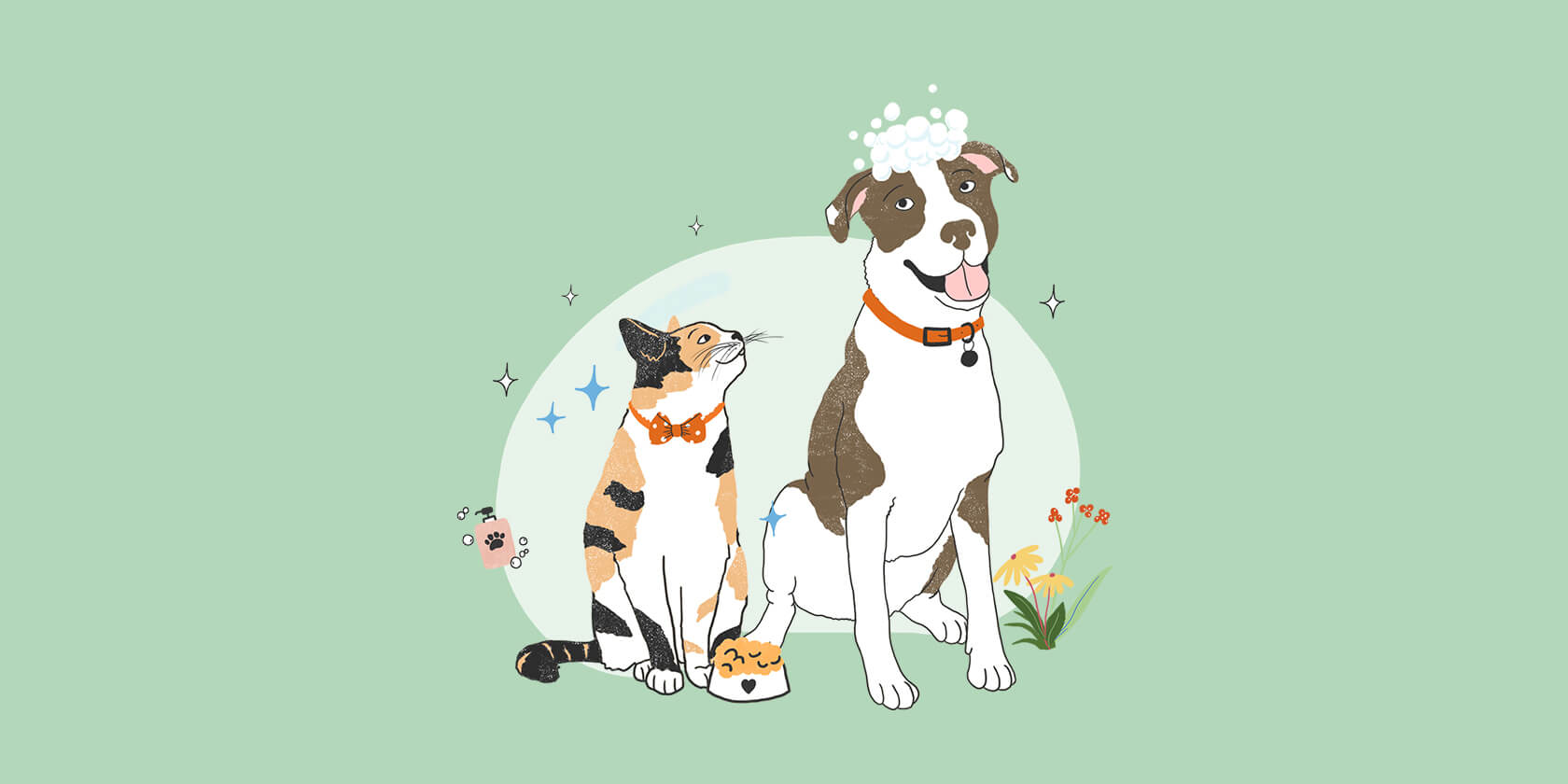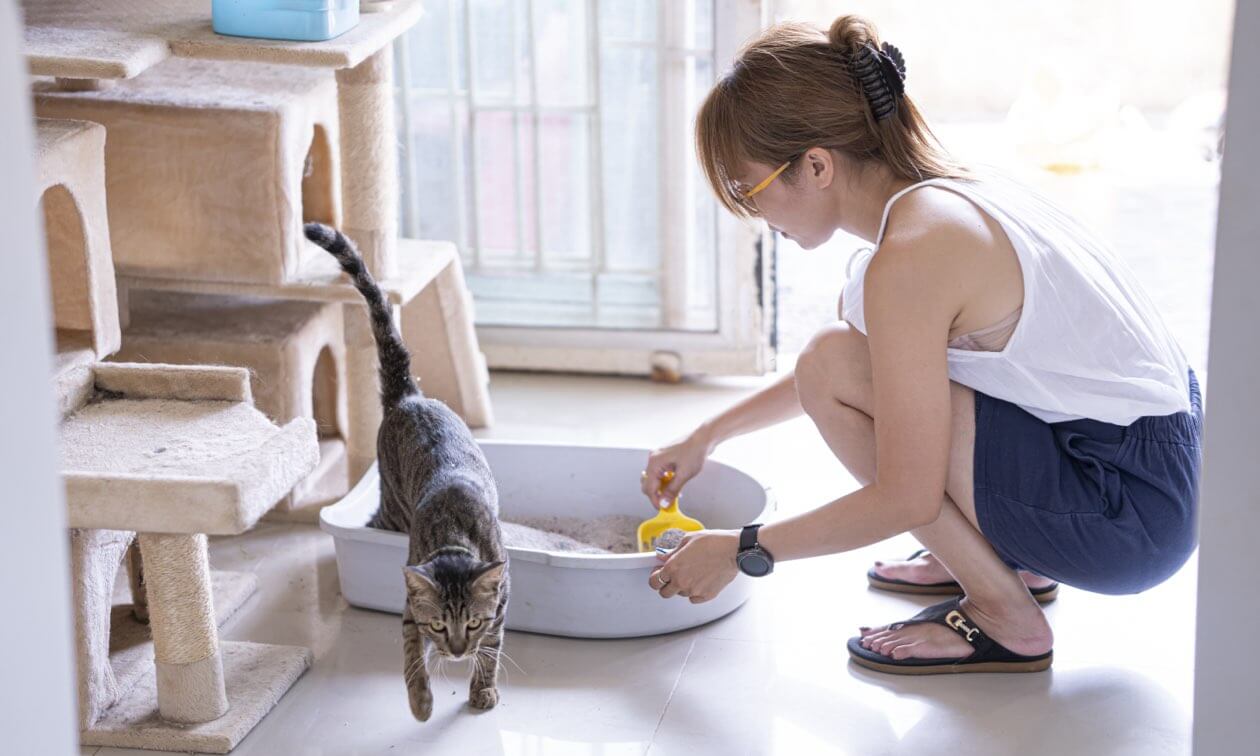Whether you save spring cleaning for spring or do deep cleaning sessions all year long, don’t forget about your pets. Not only do they contribute to some of the gunk and grime you’re cleaning off your stuff, but they also have their own stuff that needs to be cleaned, organized, and updated. From beds to bowls, litter boxes to the treat cabinet, medications to that stubborn spot on the couch, it’s helpful to know how to spring clean for our pets.

Cleaning Your Dog or Cat Bed
First up, take a good look at your pet’s bed. There comes a time when it’s just seen too much soiling, chewing, and roughhousing to go on. If the washing machine can’t get it clean or it’s been torn or frayed beyond repair, it may be time to replace it. You don’t want your dog or cat chewing off any pieces or getting their heads stuck in a torn strip of trim.
Go for pet beds with a waterproof, washable cover. It’s important to remove as much pet hair and dirt as you can before washing, so give it a good once-over with the vacuum cleaner and then tackle that hair the vacuum missed. There are lots of pet hair removal tools on the market, and sometimes just wetting your hand and rubbing it over the bed does the trick.
Next, pretreat any stains or urine and feces spots with a quality enzymatic cleaner. Then use the sanitizer or extra hot setting on your washing machine to do the hard work (if the bed manufacturer’s directions say you can). Some beds may need to be washed on a cold or gentle cycle. Unscented, clean detergents are best to avoid respiratory and skin irritation. If your pet has sensitive skin, use an extra rinse cycle. If you want to use bleach and there’s no chance it will damage the bed, about ½ cup of bleach per load of laundry is generally recommended. Adjust accordingly based on the size of your load. Let the cover dry thoroughly before your dog or cat is allowed to use it.
If the manufacturer recommends a different process, it’s best to follow their direction. Pet beds should ideally be cleaned every couple of weeks.
Cleaning Your Dog Crate
This may be something you do often if your crate gets a lot of use. Wipe the bars down with soapy water and vacuum the bottom of the crate. Then a good soak or scrub with very hot, soapy water, a rinse or wipe off, and drying is all you need. If you want deeper sanitizing, you can soak 10 minutes in a mixture of ½ cup bleach to one gallon of water followed by a thorough rinse. Rinsing is critical to make sure there is no bleach residue in the crate.
Cleaning Dog and Cat Toys
As with your pet’s bed, take a close look at toys and get rid of any that have been chewed or beaten up too much. If pieces are falling off or it’s just too gross to get clean, it’s time for a replacement. If toy is in bad shape, it may be best bet to throw it out and get a new one. If it is a favorite toy, there are some things you can do to clean it.
For non-porous toys, a wipe down with a wet cloth may be enough. Let them dry before you give them back to your dog or cat. You may have soft toys that can be washed. Check the label and follow the manufacturer’s instructions.
Soaking hard toys in one part distilled white vinegar to one part water can also clean with some limited disinfection activity (thorough rinsing is still important here).
Cleaning Dog and Cat Bowls
Cleaning your pet’s food and water dishes should be part of your weekly routine. Spring cleaning is a good time to see how they’re holding up. If they have many scratches, particularly if they’re plastic, consider replacing them. Bacteria hides out in scratches and is tough to get rid of.
For regular deep cleaning, a good soak and scrub in very hot water and dish soap is usually sufficient. If you want to go a step beyond, you can use a mixture of ½ cup bleach to one gallon of water OR one part water to one part white distilled vinegar. DO NOT mix bleach and vinegar. Be sure to rinse very well.
Deep Cleaning the Litter Box
Plastic litter boxes should be replaced every year (more often if you have multiple cats or it takes a lot of abuse from scratching and scooping). Stainless steel litter boxes don’t need replacing as often but still need a good cleaning every month or so.
To clean the litter box, remove all the old litter and fill the basin with very hot water and a little dish soap. If it’s in need of a more deep cleaning, you can add 1/2 cup of white vinegar per gallon of hot water and let it soak. Then give it a thorough rinse. When dry, add fresh litter, and you’re ready to go. Don’t forget to clean your litter scoop the same way and wipe down the area around the litter box as well.
Cleaning Furniture and Upholstery
For the sake of your sinuses, regularly vacuum your furniture to remove pet hair, dander, and dirt.
When spring cleaning comes around, an extra thorough vacuuming is a great place to start. You may have to use multiple methods to get all that hair. Try a large, sticky lint roller, or a dry sponge or rubber glove. If you have removable, washable covers, run them through the washing machine. If not, you can spot treat any stains based on the furniture manufacturer’s recommendations. This is also a good time to check buttons, rivets, trim, and other detailing to make sure nothing is coming loose or in need of repair. This helps ensure your pet can’t ingest anything that detaches from the piece.
If your pet had any accidents on your furniture, use a good-quality enzymatic cleaner to break down the chemical bonds in the urine. You might test the cleaner first to make sure it won’t damage the fabric. You can use these same tricks to clean car upholstery.
Check Expiration Dates
Spring cleaning is an ideal time to look at all your pet supplies and check expiration dates on things like:
- Medications
- Flea/tick/heartworm preventatives
- Supplements
- Treats
- Wet food
- Dry kibble
Don’t forget to check your emergency supplies as well. If you have extra pet food, water, and medications in your emergency kit, you may need to replace any that expired.
Disclaimer: Different materials require different cleaning methods. Some may negatively react to bleach, vinegar, or being run through the washing machine with very hot water. Refer to the cleaning instructions that came with the item before using the methods above.
ZPC-01715R1



